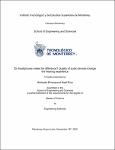| dc.contributor.advisor | Ibarra Zarate, David Isaac | |
| dc.contributor.author | Naal Ruiz, Norberto Emmanuel | |
| dc.creator | IBARRA ZARATE, DAVID ISAAC; 301007 | |
| dc.date.accessioned | 2021-10-20T03:29:03Z | |
| dc.date.available | 2021-10-20T03:29:03Z | |
| dc.date.created | 2020-11-19 | |
| dc.date.issued | 2020-11-19 | |
| dc.identifier.citation | Naal Ruiz, N. E. (2020). Do headphones make the difference? Quality of audio devices change the hearing experience (Tesis de maestría). Instituto Tecnológico y de Estudios Superiores de Monterrey, Monterrey, Nuevo León, México. Recuperado de: https://hdl.handle.net/11285/640625 | es_MX |
| dc.identifier.uri | https://hdl.handle.net/11285/640625 | |
| dc.description | https://orcid.org/0000-0003-3316-360X | es_MX |
| dc.description.abstract | The perception of sound can differ significantly, regardless of its physical properties. The
frequency content of a sound can provoke different psychoacoustic effects in humans and, at the same time, modulate differently the electrical waves of the brain. Audio devices such as headphones are variables that have not been taken into consideration in many studies concerning acoustic therapies, which strongly depend on the transmission means.
Headphones become a fundamental key in acoustic treatments since they are responsible for transmitting the auditory stimulus. It is known that the frequency response of audio devices can change the frequency content of a signal. However, it is still unknown if their limited or even inappropriate functioning could affect acoustic therapy effectiveness. Therefore, the present work aims to explore the neurophysiological responses of the brain
in healthy individuals listening to the same sound but in different headphones. For this purpose, three different frequency responses corresponding to three headphone brands (ATVIO, SHURE, and APPLE) were characterized in three different auditory stimuli.
Participants who took part in the experiment were asked to differentiate among three stimuli
in several sequences, while their electroencephalographic response was monitored.
Headphones with a flatter frequency response (SHURE) provide more acoustic information to be interpreted by the brain. In turn, more information codification demands a larger number and a wider variety of mental resources. As a case in point, the transient neural
response observed during an auditory discrimination task revealed that headphones with a flatter frequency response (SHURE) did not only activate lobes associated with decoding the physical properties of the sound and interpretation of auditory information (respectively, temporal and frontal lobes), but they also activated the region related to the spatial sense of human beings (parietal and occipital lobes). | es_MX |
| dc.format.medium | Texto | es_MX |
| dc.language.iso | eng | es_MX |
| dc.publisher | Instituto Tecnológico y de Estudios Superiores de Monterrey | es_MX |
| dc.relation | Tecnológico de Monterrey | es_MX |
| dc.relation | CONACyT | es_MX |
| dc.relation.isFormatOf | versión publicada | es_MX |
| dc.relation.isreferencedby | REPOSITORIO NACIONAL CONACYT | |
| dc.relation.url | https://www.researchgate.net/profile/Norberto_Naal-Ruiz | es_MX |
| dc.rights | openAccess | es_MX |
| dc.rights.uri | http://creativecommons.org/licenses/by-nc-nd/4.0 | es_MX |
| dc.subject.classification | INGENIERÍA Y TECNOLOGÍA::CIENCIAS TECNOLÓGICAS::TECNOLOGÍA MÉDICA::OTRAS | es_MX |
| dc.subject.lcsh | Technology | es_MX |
| dc.title | Do headphones make the difference? Quality of audio devices change the hearing experience | es_MX |
| dc.type | Tesis de Maestría / master Thesis | es_MX |
| dc.contributor.department | Escuela de Ingeniería y Ciencias | es_MX |
| dc.contributor.committeemember | Everardo Pérez, Flavio Omar | |
| dc.contributor.committeemember | Argüello García, Janet | |
| dc.contributor.mentor | Alonso Valerdi, Luz María | |
| dc.identifier.orcid | https://orcid.org/0000-0002-1203-8925 | es_MX |
| dc.subject.keyword | EEG | es_MX |
| dc.subject.keyword | Brain oscillations | es_MX |
| dc.subject.keyword | Subjective tinnitus | es_MX |
| dc.subject.keyword | Acoustic treatments | es_MX |
| dc.contributor.institution | Campus Monterrey | es_MX |
| dc.contributor.cataloger | hermlugo, emipsanchez | es_MX |
| dc.description.degree | Maestro en Ciencias de la Ingeniería | es_MX |
| dc.identifier.cvu | 963990 | es_MX |
| dc.audience.educationlevel | Investigadores/Researchers | es_MX |
| dc.relation.impreso | 2020-12-03 | |
| dc.identificator | 7||33||3314||331499 | es_MX |



